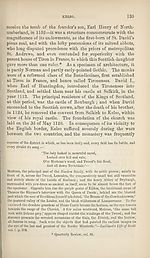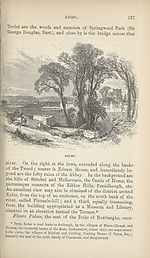Download files
Complete book:
Individual page:
Thumbnail gallery: Grid view | List view

136
EXCURSIONS PROM MELROSE.
laid waste by fire. It was reduced to its present ruinous state
by the English, under the Earl of Hertford, in 1545. The only
parts now remaining are the walls of the transepts, the centre
tower, and west end, and a small part of the choir. After the
Reformation a low gloomy vault was thrown over the transept,
to make it serve as a parish church, and it continued to be used
for this purpose till 1771, when one Sunday, during divine
service, the congregation were alarmed by the falling of a piece
of plaster from the roof, and hurried out in terror, believing
that the vault over their heads was giving way ; and this,
together with an ancient prophecy, attributed to Thomas the
Rhymer, “ that the kirk should fall when at the fullest,”
caused the church to be deserted, and it has never since had
an opportunity of tumbling on a full congregation. The ruins
were disencumbered of the rude modem masonry by the good
taste of William Duke of Roxburghe and his successor Duke
James ; and, in 1823, the decayed parts were strengthened and
repaired by subscription. After the Reformation, the principal
part of the estates of this rich abbey were held in commendam
by Sir John Maitland, the ancestor of the Earl of Lauderdale,
who exchanged it with Francis Stewart, afterwards Earl of
Bothwell, for the priory of Coldinghame. This nobleman, for
his repeated treasons, was attainted in 1592, and the lands and
possessions of Kelso Abbey were finally conferred upon Sir
Robert Ker of Cessford, and they are still enjoyed by his des¬
cendant, the Duke of Roxburghe.
The environs of Kelso, which are singularly beautiful, are
thus described by Leyden, in his Scenes of Infancy :—
“ Bosom’d in woods where mighty rivers run,
Kelso’s fair vale expands before the sun.
Its rising downs in vernal beauty swell,
And, fringed with hazel, winds each flowery dell,
Green spangled plains to dimpling lawns succeed,
And Tempe rises on the hanks of Tweed,
Blue o’er the river Kelso’s shadow lies.
And copse-clad isles amid the waters rise.”
The most admired view is from the bridge, looking up the
river. In this view are comprehended the junction of the
Tweed and Teviot, and the ruins of Roxburgh Castle ; in front,
the palace of Fleurs, with its lawns sloping to the river’s edge,
and sheltered by lofty trees behind. On the south bank of the
EXCURSIONS PROM MELROSE.
laid waste by fire. It was reduced to its present ruinous state
by the English, under the Earl of Hertford, in 1545. The only
parts now remaining are the walls of the transepts, the centre
tower, and west end, and a small part of the choir. After the
Reformation a low gloomy vault was thrown over the transept,
to make it serve as a parish church, and it continued to be used
for this purpose till 1771, when one Sunday, during divine
service, the congregation were alarmed by the falling of a piece
of plaster from the roof, and hurried out in terror, believing
that the vault over their heads was giving way ; and this,
together with an ancient prophecy, attributed to Thomas the
Rhymer, “ that the kirk should fall when at the fullest,”
caused the church to be deserted, and it has never since had
an opportunity of tumbling on a full congregation. The ruins
were disencumbered of the rude modem masonry by the good
taste of William Duke of Roxburghe and his successor Duke
James ; and, in 1823, the decayed parts were strengthened and
repaired by subscription. After the Reformation, the principal
part of the estates of this rich abbey were held in commendam
by Sir John Maitland, the ancestor of the Earl of Lauderdale,
who exchanged it with Francis Stewart, afterwards Earl of
Bothwell, for the priory of Coldinghame. This nobleman, for
his repeated treasons, was attainted in 1592, and the lands and
possessions of Kelso Abbey were finally conferred upon Sir
Robert Ker of Cessford, and they are still enjoyed by his des¬
cendant, the Duke of Roxburghe.
The environs of Kelso, which are singularly beautiful, are
thus described by Leyden, in his Scenes of Infancy :—
“ Bosom’d in woods where mighty rivers run,
Kelso’s fair vale expands before the sun.
Its rising downs in vernal beauty swell,
And, fringed with hazel, winds each flowery dell,
Green spangled plains to dimpling lawns succeed,
And Tempe rises on the hanks of Tweed,
Blue o’er the river Kelso’s shadow lies.
And copse-clad isles amid the waters rise.”
The most admired view is from the bridge, looking up the
river. In this view are comprehended the junction of the
Tweed and Teviot, and the ruins of Roxburgh Castle ; in front,
the palace of Fleurs, with its lawns sloping to the river’s edge,
and sheltered by lofty trees behind. On the south bank of the
Set display mode to:
![]() Universal Viewer |
Universal Viewer | ![]() Mirador |
Large image | Transcription
Mirador |
Large image | Transcription
| Antiquarian books of Scotland > Scotland/Scots > Black's picturesque tourist of Scotland > (196) |
|---|
| Permanent URL | https://digital.nls.uk/130030542 |
|---|
| Description | Thousands of printed books from the Antiquarian Books of Scotland collection which dates from 1641 to the 1980s. The collection consists of 14,800 books which were published in Scotland or have a Scottish connection, e.g. through the author, printer or owner. Subjects covered include sport, education, diseases, adventure, occupations, Jacobites, politics and religion. Among the 29 languages represented are English, Gaelic, Italian, French, Russian and Swedish. |
|---|

